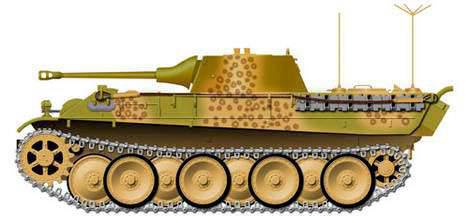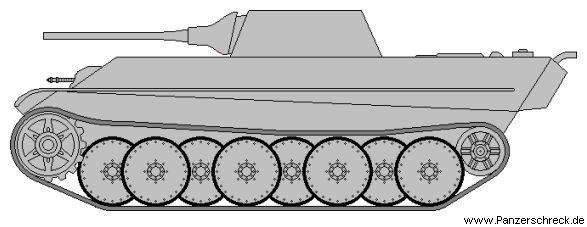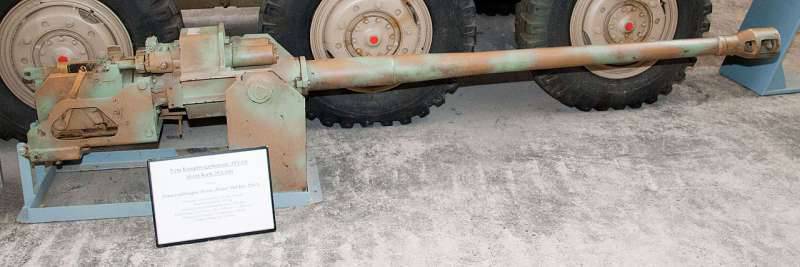The project of heavy reconnaissance tank Daimler-Benz VK 2801 (Germany)
One of the main reasons for the rejection of the two VK 1602 projects created by Daimler-Benz and MAN / MIAG were insufficient characteristics. It was assumed that these machines will work in some combat formations with other tanks, including the newest "Tigers" and "Panthers". In this case, however, the reconnaissance vehicles in the proposed form lagged behind other armored vehicles in terms of protection. The 50-mm KwK 39 gun selected for their weapons did not, in turn, provide the required firepower. As a result, the further development of projects was considered inexpedient.
After the cessation of work on the reconnaissance tank VK 1602, before the end of 1942, Daimler-Benz decided to start developing a new project of a similar purpose. At this time, it was proposed to correct the main shortcomings of the previous project, and thus provide promising tanks great prospects. According to reports, the new project was developed without a corresponding order from the military, because of what did not receive an official designation. However, in foreign and domestic sources, it is often referred to as VK 2801 or VK 2801 (DB). Letters in brackets are used to eliminate confusion with a later similar project by Krupp.

A variant of the reconstruction of the appearance of the tank VK 2801 (DB). Figure Aviarmor.net
An analysis of the requirements and capabilities has shown that a new project, free from the shortcomings of the existing one, cannot be created by simple modernization. It was necessary to develop a new armored hull with enhanced protection characteristics, which led to the need for a new enhanced chassis, the use of a more powerful engine, etc. As a result, in its appearance, the VK 2801 tank should have been significantly different from the previously proposed vehicle. In addition, at a certain stage of development, there was a noticeable external similarity with some other tanks of the newest models.
It should be noted that the Daimler-Benz VK 2801 project was stopped at one of the early stages, which negatively affected the information about it. Thus, different sources provide different information. In addition, there are some problems associated with confusion and the same names of the two developments. Let's try to establish the appearance of the proposed tank.
VK 1602 proposed the use of frontal armor 50 mm thick, but in the middle of 1942, such protection was considered insufficient. Later it was proposed to strengthen the frontal protection of a reconnaissance tank up to 80 mm of armor with installation at an angle to the vertical. In the new project, the Daimler-Benz engineers decided to further increase the thickness of the armor. The upper frontal part, installed at an angle, should now have a thickness of 90 mm. In a proportional way, it was necessary to strengthen the protection of other parts of the machine.
Due to the impossibility of a simple update of the existing project with the use of thicker armor, the authors of the development had to start designing a new building. According to reports, the resulting unit had a great similarity with some other new German tanks. There was a sloping frontal sheet, connected with vertical sides and a horizontal roof. The upper part of the hull was expanded and formed large, nadgusenichnye niche, with the help of which increased the available volume to accommodate the necessary nodes. The stern leaf was inclined backward, giving the car an additional resemblance to some other specimens.
VK VK 2801 (DB) was proposed to be assembled in accordance with standard German ideas. In the front part there should have been transmission units, behind which was placed the office with the driver and radio operator. The central part of the body stood out under the fighting compartment with weapons and ammunition, and in the stern provided for the installation of the engine.
To ensure acceptable mobility, a prospective reconnaissance tank, differing from its predecessor by increased weight, should have received a more powerful engine. The Maybach HL 230 carburetor power 700 hp was proposed as the basis of the power plant. With the help of a cardan shaft, passing over the bottom of the case, he had to transmit torque to the front units of the mechanical transmission. The latter were associated with two driving wheels.
Creating a new building of large dimensions and increased mass required the authors of the project to apply the new chassis. To reduce the ground pressure and improve the ride smoothness, the VK 2801 tank received eight large-diameter road wheels with an individual suspension on each side. In addition, the so-called. Knipkamp suspension with a checkerboard arrangement and partial overlapping of rollers. In front of the hull were driving wheels with pinching gear, in the stern - leading ones. The latter were partially overlapped by rear idler wheels.
On the roof of the hull it was proposed to install a tower with weapons. According to some reports, the tower was supposed to receive a rectangular frontal sheet and sides with the stern, made in the form of a single curved part. Above, there was a horizontal roof with hatches and viewing devices. The level of defense of the tower, apparently, should correspond to the similar parameters of the hull. On the gun installation, a mask of a complex form like Saukopf was located.
In the turret of the new VK 2801 (DB), the 5 cm KwK 39 L / 60 gun should have been installed, similar to that used in the VK 1602 project. This gun was equipped with 50-mm barrel length 60 calibers. It should be noted that for 1942-43 the use of such weapons on medium or heavy tanks it was no longer advisable. Thus, when using a Pz.Gr.40 projectile with an initial speed of 1180 m / s, the gun could penetrate 130 mm of armor only from a distance of 100 m. At a distance of 1 km, armor penetration fell to 38 mm. Perhaps, in the future, the prospective reconnaissance tank could have received a more powerful weapon that would meet the requirements of the time, but there are no data to that effect.
Additional armament of the tank was to consist of two MG 34 machine guns or MG 42 caliber 7,92 mm. One of the machine guns was proposed to be mounted on the same machine with the gun, and the second was to be placed in the embrasure of the front hull plate. There is no information about the possible use of smoke grenade launchers.
The crew of a prospective reconnaissance tank was to consist of four or five people. In front of the hull, a mechanic-driver and a radio operator shooter were placed, for whom, probably, their own hatches were provided for in the hull roof. The commander, the gunner and the loader were supposed to control the armament (according to some information, the commander should have been the gunner’s duties). Their places were placed in the tower and equipped with a set of hatches with viewing devices.
The reconnaissance mission of the new armored vehicle should have affected the set of onboard equipment. The radio operator should have several radio stations in place to communicate with other tanks and transmit data about the detected targets. In this regard, in some variants of the reconstruction of the VK 2801 look, there is a set of antennas providing communication with other tanks.

Another option is the appearance of the tank. Figure Aviarmor.net
The design of the new case with enhanced protection characteristics led to a regular increase in the size and weight of the structure. The total length of the VK 2801 (DB) tank was to reach 6,5 m, while the three-meter barrel of the 50-mm gun did not protrude beyond the hull projection. The width of the machine did not exceed 3 m, height - 2,8 m. Due to the powerful booking, the tank's combat mass reached 33 tons. The use of an 700-powerful gasoline engine gave a specific power of at least 21,2 hp. per ton, which allowed to count on good indicators of mobility.
Approximately at the end of 1942, or at the beginning of 1943, a new development, created on its own initiative, was presented to the military. The machine, created without ordering the army, was not interested in command. It can be assumed that this failure had several reasons. The main reason for the closure of the project could be the lack of a need for such a technique: if the army would really need a heavy reconnaissance tank, they would definitely have ordered it.
An additional reason for justified claims could be weak weaponry. The 50-mm KwK 39 cannon no longer allowed to contend with modern enemy tanks without significant risk to themselves. For the sure defeat of Soviet tanks, the VK 2601 machine would have to enter their defeat zone. This problem could be partially solved by enhanced booking, but the tank still needed more powerful weapons.
A noticeable increase in general characteristics could be facilitated by the use of a more powerful weapon, proposed even during the development of the VK 1602 project. Indeed, the reconnaissance tank VK 2801 (DB) with 80-mm frontal armor and 75-mm gun in terms of protection and firepower could be compared with the Pz.Kpfw.V Panther armored vehicle. However, this did not justify the new development, since the Wehrmacht did not need to duplicate an already existing tank.
For one reason or another, the Daimler-Benz VK project did not interest the potential customer and was closed as unnecessary. For several months of work, the design team managed to prepare a set of drawings, but the work did not progress further. Information about building a demo layout is missing. The prototype of the new machine was not built and was not even planned because of the early cessation of work. All project documentation has been archived. Some ideas later found application in new developments. In addition, an attempt was soon made to create a new armored vehicle based on some of the developments of the VK 2801 (DB) project. The development of this project with the same name was entrusted to Krupp.
Based on:
http://aviarmor.net/
http://alternathistory.com/
http://achtungpanzer.com/
Baryatinsky M. Scouts battle // Model-designer. 2001. No.11. C.32.
Chamberlain P., Doyle H. Complete reference book of German tanks and self-propelled guns of the Second World War. - M .: AST: Astrel, 2008.

Information